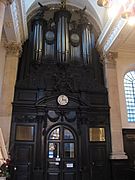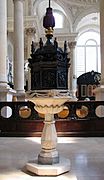St Stephen Walbrook facts for kids
Quick facts for kids St Stephen Walbrook |
|
|---|---|
 |
|
| Location | 39 Walbrook, Walbrook, London EC4N 8BN |
| Country | England |
| Denomination | Church of England |
| Previous denomination | Roman Catholic |
| Website | https://ststephenwalbrook.net/ |
| Architecture | |
| Heritage designation | Grade I listed building |
| Architect(s) | Sir Christopher Wren |
| Style | Baroque |
| Administration | |
| Diocese | London |
St Stephen Walbrook is a famous church located in the City of London, England. It's part of the Church of England. The church you see today was designed by the famous architect Sir Christopher Wren. It was built after the original church was destroyed in the terrible Great Fire of London in 1666. You can find it in an area called Walbrook, right next to the Mansion House. It's also very close to the Bank and Monument Underground stations.
Contents
A Look Back: Early History of the Church
The very first St Stephen church stood on the west side of a street called Walbrook. It was also on the east bank of the River Walbrook, which was once an important stream for the Romans. People think the first church might have been built right over the remains of an old Roman Mithraic Temple. Christians often built churches on places that were once used for other religions.
The church was moved to its current spot in the 1400s. This new location was on the other side of Walbrook Street. In 1429, a man named Robert Chichele bought the land and gave it to the church parish. The first stones were laid on May 11, 1429. The church was officially ready ten years later, on April 30, 1439. This older church was much bigger than the one we see today. It was about 38 meters (125 feet) long and 20 meters (67 feet) wide.
Sadly, this church was completely destroyed in the Great Fire of London in 1666. A memorial to the composer John Dunstaple was inside. The words from his memorial were recorded in the early 1600s and put back in the church in 1904. Another nearby church, St Benet Sherehog, was also destroyed and never rebuilt. Its parish then joined with St Stephen's.
Sir Christopher Wren's Amazing Design
The church building you see now was built between 1672 and 1679. It was designed by the famous architect Sir Christopher Wren. The building cost about £7,692, which was a lot of money back then! The main builder was Thomas Strong, and his brother Edward Strong the Elder also helped. Edward Strong the Younger built the spire.
The church has a rectangular shape with a large dome and a tower on the northwest side. To enter the church, you walk up sixteen steps into a porch at the front. Wren had planned another porch for the north side, but it was never built. There used to be a north door, but it was closed up in 1685. This was because bad smells from nearby slaughterhouses were coming into the church!
The walls, tower, and columns inside are made of stone. However, the dome is made of wood and plaster, covered with copper on the outside.
The Stunning Dome
The dome is about 19 meters (63 feet) high. It's based on Wren's first ideas for St Paul's. The dome sits on a square of twelve columns. The round base of the dome is supported in a special way. Eight arches spring from eight of the twelve columns, cutting across each corner. This unique design makes the inside of the church one of Wren's most beautiful works. Sir Nikolaus Pevsner, a famous expert on buildings, even called it one of the ten most important buildings in England.
The church also has amazing carved wooden furnishings. These include the altarpiece, the Royal Arms, the pulpit, and the font cover. These were made by talented carpenters and carvers like Thomas Creecher, Stephen Colledge, William Newman, and Jonathan Maine.
In 1760, a new organ was added by George England. Later, in 1776, a painting by Benjamin West called Devout Men Taking Away the Body of St Stephen was put in the church. The rector, Thomas Wilson, had asked for this painting. He also placed a statue of Catharine Macaulay, a political writer he admired, in the church. But people protested, and the statue was removed. The painting was later moved to a different wall during repairs in 1850.
Modern Times: Recent History

The church had some minor damage from bombs during the London Blitz in 1941. It was later repaired. In 1954, the parishes of St Mary Bothaw and St Swithin London Stone joined with St Stephen's.
On January 4, 1950, the church was given a special status as a Grade I listed building. This means it's a very important historical building.
The Samaritans Charity
In 1953, a very important charity called the Samaritans was started by the church's rector, Dr Chad Varah. The very first Samaritans office was in a crypt (an underground room) beneath the church. They later moved to a different street. To remember this, a telephone is kept in a glass box inside the church. The Samaritans started with this phone, and today they have volunteers who answer a 24-hour phone line for people who need emotional support.
New Altar and Art
In 1987, the church had major repairs and changes. A large white stone altar was placed in the center of the church. This altar was made by the famous sculptor Henry Moore. Its unusual position needed special permission from a court. In 1993, colorful kneelers (cushions for kneeling) designed by Patrick Heron were added around the altar.
The painting by Benjamin West, Devout men taking away the body of St Stephen, was put into storage after these changes. This was a bit controversial. In 2013, the church was allowed to sell the painting to a foundation. It was later loaned to the Museum of Fine Arts in Boston, where it was restored.
On July 14, 1994, the church was the place where Lady Sarah Armstrong-Jones married Daniel Chatto.
Dr Chad Varah, who started the Samaritans, retired in 2003 at the age of 92. He was the oldest serving church leader in the Church of England at that time.
Notable People Buried Here
- Sir Rowland Hill, who helped publish the 1560 Geneva Bible. His memorial was lost in the Great Fire but later put back at Hawkstone.
- John Dunstaple, a famous musician.
- Elizabeth Jekyll (1624-1653), a diarist.
- John Vanbrugh, an architect.
The closest London Underground station to the church is Bank.
Gallery
See also










